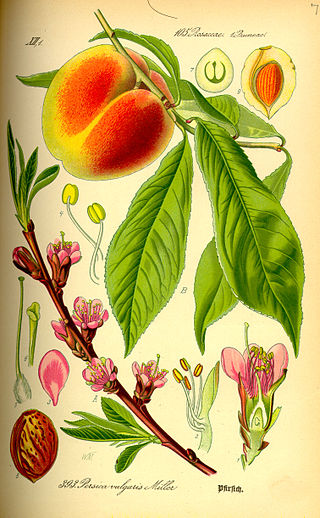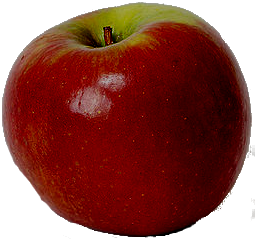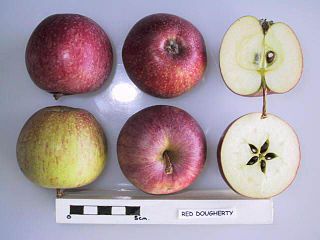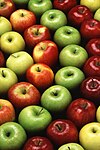
Kiwifruit or Chinese gooseberry is the edible berry of several species of woody vines in the genus Actinidia. The most common cultivar group of kiwifruit is oval, about the size of a large hen's egg: 5–8 centimetres in length and 4.5–5.5 cm in diameter. It has a thin, fuzzy, fibrous, tart but edible light brown skin and light green or golden flesh with rows of tiny, black, edible seeds. The fruit has a soft texture with a sweet and unique flavour.

The McIntosh, McIntosh Red, or colloquially the Mac, is an apple cultivar, the national apple of Canada. The fruit has red and green skin, a tart flavour, and tender white flesh, which ripens in late September. In the 20th century it was the most popular cultivar in Eastern Canada and New England, and is considered an all-purpose apple, suitable both for cooking and eating raw.

The peach is a deciduous tree first domesticated and cultivated in Zhejiang province of Eastern China. It bears edible juicy fruits with various characteristics, most called peaches and others, nectarines.

Fruit tree propagation is usually carried out vegetatively (non-sexually) by grafting or budding a desired variety onto a suitable rootstock.

The Granny Smith, also known as a green apple or sour apple, is an apple cultivar which originated in Australia in 1868. It is named after Maria Ann Smith, who propagated the cultivar from a chance seedling. The tree is thought to be a hybrid of Malus sylvestris, the European wild apple, with the domesticated apple Malus domestica as the polleniser.

Syzygium samarangense is a species of flowering plant in the family Myrtaceae, native to an area that includes the Greater Sunda Islands, Malay Peninsula, and the Andaman and Nicobar Islands, but introduced in prehistoric times to a wider area and now widely cultivated in the tropics. Common names in English include wax apple, Java apple, Semarang rose-apple, and wax jambu.

Cox's Orange Pippin, in Britain often referred to simply as Cox, is an apple cultivar first grown in 1825, at Colnbrook in Buckinghamshire, England, by the retired brewer and horticulturist Richard Cox. Though the parentage of the cultivar is unknown, Ribston Pippin seems a likely candidate. DNA analysis of major apple pedigrees has suggested Margil as the parent of Cox, with Ribston Pippin being another Margil seedling. The variety was introduced for sale by the 1850s by Charles Turner, and grown commercially from the 1860s, particularly in the Vale of Evesham in Worcestershire, and later in Kent. A paper by Howard et al seems to suggest that the Cox Orange Pippin is a hybrid between the Cultivars: Rosemary Russet and Margil based on the SNP data 7

The Braeburn is a cultivar of apple that is firm to the touch with a red/orange vertical streaky appearance on a yellow/green background. Its color intensity varies with different growing conditions.

Honeycrisp is an apple cultivar developed at the Minnesota Agricultural Experiment Station's Horticultural Research Center at the University of Minnesota, Twin Cities. Designated in 1974 with the MN 1711 test designation, patented in 1988, and released in 1991, the Honeycrisp, once slated to be discarded, has rapidly become a prized commercial commodity, as its sweetness, firmness, and tartness make it an ideal apple for eating raw. "...The apple wasn't bred to grow, store or ship well. It was bred for taste: crisp, with balanced sweetness and acidity." It has larger cells than most apple cultivars, a trait which is correlated with juiciness, as theoretically a higher number of cells rupture when bitten, releasing more juice in the mouth. The Honeycrisp also retains its pigment well and has a relatively long shelf life when stored in cool, dry conditions. Pepin Heights Orchards delivered the first Honeycrisp apples to grocery stores in 1997. The name Honeycrisp was trademarked by the University of Minnesota, but university officials were unsure of its protection status in 2007. It is now the official state fruit of Minnesota. A large-sized honeycrisp will contain about 113 calories.

Antonovka is a group of late-fall or early-winter apple cultivars with a strong acid flavor that have been popular in Russia as well as in Poland and Belarus. The most popular Russian variety is Common Antonovka, from which other cultivars derive. It was developed by pioneer Russian naturalist and plant breeder Ivan V. Michurin at his experimental orchard in the Tambov Oblast and introduced in 1888.

Cripps Pink is a cultivar of apple. It is one of several cultivars sold under the trade mark name Pink Lady. It was originally bred by John Cripps at the Western Australia Department of Agriculture, by crossing the Australian apple Lady Williams with a Golden Delicious; the result is a combination of the firm, long-storing property of Lady Williams with the sweetness and lack of storage scald of Golden Delicious.

An apple is an edible fruit produced by an apple tree. Apple trees are cultivated worldwide and are the most widely grown species in the genus Malus. The tree originated in Central Asia, where its wild ancestor, Malus sieversii, is still found today. Apples have been grown for thousands of years in Asia and Europe and were brought to North America by European colonists. Apples have religious and mythological significance in many cultures, including Norse, Greek, and European Christian tradition.

Coprosma repens is a species of flowering shrub or small tree of the genus Coprosma, in the family Rubiaceae, native to New Zealand. Common names include taupata, tree bedstraw, mirror bush, looking-glass bush, New Zealand laurel and shiny leaf.

Aurora Golden Gala is a cross between the apples 'Splendour' and 'Gala'. It was named in 2003 in a nationwide "Name the Apple" contest. Aurora Golden Gala is a yellow dessert apple. It is harvested mid-season. The fruit are medium in size, very crisp, juicy, aromatic, sweet, and they store well.
Nicola is the trade name of the apple cultivar SPA440, a cross between the apples 'Splendour' and 'Gala' made at the Pacific Agri-Food Research Centre (PARC), Summerland, BC. Nicola is a mid-late season apple, typically harvested at 3-4 on the Cornell general Starch chart. Fruit is bicolour, large in size and typically a solid fire engine red over colour, (~80%) over a yellow-green background colour. Fruit is crisp, juicy, and sweet and stores well, with full aromatic flavours developing after several weeks of storage.

The 'Laxton's Superb' is an apple cultivar that was developed in England in 1897. It is a cross breed between Cellini and 'Cox's Orange Pippin' and is not a cross between Wyken Pippin and Cox Orange Pippin. It is a British apple with a green color and a dull red flush. It is a firm-textured dessert apple. The fruit is well known for its sweet and aromatic taste which is likened to the parent species it is derived from, the 'Cox's Orange Pippin'. Density 0,82 g/cc, sugar 14,0%, acid 7,4 g/litre. Vitamin C 9mg/100g.

Golden Russet is an old American cultivar of domesticated apple which is excellent for fresh eating as well as for apple cider production. It is a russet apple and is therefore especially used as a cider apple. It is sometimes known as 'English Golden Russet', and has frequently been confused with 'English Russet'.

Sciros is a cultivar of domesticated apple. This apple is mostly sweet with very little acidity, often compared to the 'Fuji' apple for taste, and keeps very well in storage. According to Orange Pippin it is an attractive new late-season high-quality dessert apple, a hybrid between 'Gala' and 'Splendour' apples, mostly resembling the latter.

'Dougherty' was an Australian cultivar of domesticated apple, which was grown mainly for export to the United Kingdom, from which a red colored mutation is marketed today as 'Red Dougherty'. 'Dougherty' produces medium-sized fruits at late season, skin background is greenish-yellow and flushed with some red. Flesh is yellowish with sweet flavour.
Susan Elizabeth Gardiner is a New Zealand horticultural scientist, who works on using genetics and genomics for fruit breeding. Gardiner has received multiple awards. Gardiner has been a Fellow of the Royal Society Te Apārangi since 2020 and is a Fellow of the International Society for Horticultural Science. She is an Honorary Fellow of Plant & Food Research.




















